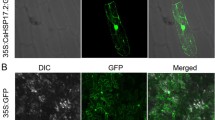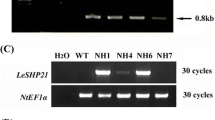Abstract
The chloroplast HSP100/ClpB is a newly documented member of the ClpB family, but little was known about its role in imparting thermotolerance to cells. A cDNA coding for a HSP100/ClpB homolog has been cloned from Lycopersicon esculentum and termed as Lehsp100/ClpB (the cDNA sequence of Lehsp100/ClpB has been submitted to the GenBank database under accession number: AB219939). The protein encoded by the cDNA was most similar to the putative chloroplast HSP100/ClpBs in higher plants and the ClpB from Cyanobacterium Synechococcus sp. A 97 kDa protein, which matched the predicted size of mature LeHSP100/ClpB, was immunologically detected in chloroplast isolated from heat-treated tomato plants. In addition, the fusion protein, combining the transit sequence of LeHSP100/ClpB and GFP, was found to be located in chloroplast based on the observations of fluorescent microscope images. These results indicated the chloroplast-localization of LeHSP100/ClpB. Both the transcript and the protein of Lehsp100/ClpB were not detected under normal growth conditions, but they were induced by increasingly higher temperatures. An antisense Lehsp100/ClpB cDNA fragment was introduced into the tomato by Agrobacterium-mediated transformation. Antisense lines exhibited an extreme repression of heat-induced expression of Lehsp100/ClpB. The levels of chloroplast HSP60 and small HSP in antisense lines were identical to those of the control plants. After plants preconditioned at 38°C for 2 h were exposed to a lethal heat shock at 46°C for 2 h, the antisense lines were greatly impaired and withered in 21 days of the recovery phase, whereas the untransformed control plants and the vector-transformed plants survived. Furthermore, chlorophyll fluorescence measurements showed that PS II in antisense lines were more susceptible to the thermal irreversible inactivation than the untransformed and vector-transformed control plants. This work provides the first example that induction of chloroplast LeHSP100/ClpB contributes to the acquisition of thermotolerance in higher plants.
Similar content being viewed by others
References
Agarwal M, Sahi C, Katiyar-Agarwal S, Agarwal S, Young T, Gallie DR, Sharma VM, Ganesan K, Grover A (2003) Molecular characterization of rice hsp101: complementation of yeast hsp104 mutation by disaggregation of protein granules and differential expression in indica and japonica rice types. Plant Mol Biol 51(4):543–553
Agarwal M, Katiyar-Agarwal S, Sahi C, Gallie DR, Grover A (2001) Arabidopsis thaliana Hsp100 proteins: kith and kin. Cell Stress Chaperones 6(3):219–224
Armond PA, Bjorkman O, Staehelin LA (1980) Dissociation of supramolecular complexes in chloroplast membranes. A manifestation of heat damage to the photosynthetic apparatus. Biochim Biophys Acta 601:433–443
Berry J, Björkman O (1980) Photosynthetic response and adaptation to temperature in higher plants. Annu Rev Plant Physiol 31:491–543
Bilger HW, Schreiber U, Lange OL (1984) Determination of leaf heat-resistance—comparative investigation of chlorophyll fluorescence changes and tissue necrosis methods. Oecologia 63:256–262
Bruce B, Perry S, Froehlich J, Keegstra K (1994) In vitro import of proteins into chloroplasts. In: Gelvin SB, Schilperoot RB (eds) Plant molecular biology manual. Kluwer Academic Publishers, Boston, pp 1–15
Eriksson MJ, Clarke AK (1996) The heat shock protein ClpB mediates the development of thermotolerance in the Cyanobacterium Synechococcus sp. strain PCC (7942). J Bacteriol 178:4839–4846
Eriksson MJ, Clarke AK (2000) The Escherichia coli heat shock protein ClpB restores acquired thermotolerance to a cyanobacterial ClpB deletion mutant. Cell Stress Chaperones 5:255–264
Gallie DR, Fortner D, Peng J, Puthoff D (2002) ATP-dependent hexameric assembly of the heat shock protein Hsp101 involves multiple interaction domains and a functional C-proximal nucleotide-binding domain. J Biol Chem 277:39617–39626
Havaux M (1993) Characterisation of thermal damage to the photosynthetic electron transport system in potato leaves. Plant Sci 94:19–33
Holsters M, De Waele D, Depicker A, Messens E, Van Montagu M, Schell J (1978) Transfection and transformation of Agrobacterium tumefaciens. Mol Gene Genom 163:181–187
Hong SW, Vierling E (2000) Mutants of Arabidopsis thaliana defective in the acquisition of tolerance to high temperature stress. Proc Natl Acad Sci USA 97:4392–4397
Horsch RB, Fry JE, Hoffmann NL, Eichholtz D, Rogers SG, Fraley RT (1985) A simple and general method for transferring genes into plants. Science 227:1229–1231
Hoskins JR, Pak M, Maurizi MR, Wickner S (1998) The role of the ClpA chaperone in proteolysis by ClpAP. Proc Natl Acad Sci USA 95:12135–12140
Jin TE, Kim IG, Kim WS, Suh SC, Kim BD, Rhim SL (2001) Expression of chromium (VI) reductase gene of heavy metal reducing bacteria in tobacco plants. J Plant Biotechnol 3:13–17
Kawai R, Fujita K, Iwahashi H, Komatsu Y (1999) Direct evidence for the intracellular localization of Hsp104 in Saccharomyces cerevisiae by immunoelectron microscopy. Cell Stress Chaperones 4(1):46–53
Keeler SJ, Boettger CM, Haynes JG, Kuches KA, Johnson MM, Thureen DL, Keeler CL Jr, Kitto SL (2000) Acquired thermotolerance and expression of the HSP100/ClpB genes of lima bean. Plant Physiol 123:1121–1132
Law RD, Crafts-Brandner SJ (1999) Inhibition and acclimation of photosynthesis to heat stress is closely correlated with activation of ribulose-1,5-bisphosphate carboxylase/oxygenase. Plant Physiol 120:173–181
Lee U, Wie C, Escobar M, Williams B, Hong SW, Vierling E (2005) Genetic analysis reveals domain interactions of Arabidopsis Hsp100/ClpB and cooperation with the small heat shock protein chaperone system. Plant Cell 17:559–571
Lee YRJ, Nagao RT, Key LJ (1994) A soybean 101-KD heat shock protein complements a yeast HSP 104 deletion mutant in acquiring thermotolerance. Plant Cell 6:1889–1897
Mogk A, Deuerling E, Vorderwülbecke S, Vierling E, Bukau B (2003) Small heat shock proteins, ClpB and the DnaK system form a functional triade in reversing protein aggregation. Mol Microbiol 50:585–595
Neta-Sharir I, Isaacson T, Lurie S, Weiss D (2005) Dual role for tomato heat shock protein 21: protecting Photosystem II from oxidative stress and promoting color changes during fruit maturation. Plant Cell 17:1829–1838
Nieto-Sotelo J, Kannan KB, Segal MC (1999) Characterization of a maize heat-shock protein 101 gene, HSP101, encoding a ClpB/Hsp100 protein homologue. Gene 230:187–195
Nieto-Sotelo J, Martinez LM, Ponce G, Cassab GI, Alagon A, Meeley RB, Ribaut JM, Yang R (2002) Maize HSP101 plays important roles in both induced and basal thermotolerance and primary root growth. Plant Cell 14:1621–1633
Preczewski P, Heckathorn SA, Downs CA, Coleman JS (2000) Photosynthetic thermotolerance is positively and quantitatively correlated with production of specific heat-shock proteins among nine genotypes of tomato. Photosynthetica 38:127–134
Queitsch C, Hong SW, Vierling E, Lindquist S (2000) Heat shock protein 101 plays a crucial role in thermotolerance in Arabidopsis. Plant Cell 12:479–492
Ragueh F, Lescure N, Roby D, Marco Y (1989) Gene expression in Nicotiana tabacum in response to compatible and incompatible isolates of Pseudomonas solonaciarum. Physiol Mol Plant Pathol 35:23–33
Salvucci ME, Crafts-Brandner SJ (2004) Relationship between the heat tolerance of photosynthesis and the thermal stability of Rubisco activase in plants from contrasting thermal environments. Plant Physiol 134:1460–1470
Sanchez Y, Lindquist SL (1990) HSP104 required for induced thermotolerance. Science 248:1112–1115
Sauer RT, Bolon DN, Burton BM, Burton RE, Flynn JM, Grant RA, Hersch GL, Joshi SA, Kenniston JA, Levchenko I, Neher SB, Oakes ES, Siddiqui SM, Wah DA, Baker TA (2004) Sculpting the proteome with AAA(+) proteases and disassembly machines. Cell 119:9–18
Schirmer EC, Glover JR, Singer MA, Lindquist S (1996) HSP100/Clp proteins: a common mechanism explains diverse functions. Trends Biochem Sci 21:289–296
Schirmer EC, Lindquist S, Vierling E (1994) An Arabidopsis heat shock protein complements a thermotolerance defect in yeast. Plant Cell 6:1899–909
Schroda M, Vallon O, Wollman FA, Beck CF (1999) A chloroplast-targeted heat shock protein 70 (HSP70) contributes to the photoprotection and repair of photosystem II during and after photoinhibition. Plant Cell 11:1165–1178
Singh SK, Grimaud R, Hoskins JR, Wickner S, Maurizi MR (2000) Unfolding and internalization of proteins by the ATP-dependent proteases ClpXP and ClpAP. Proc Natl Acad Sci USA 97:8898–8903
Squires CL, Pedersen S, Ross BM, Squires C (1991) ClpB is the Escherichia coli heat shock protein F84.1. J Bacteriol 173:4254–4262
Wang D, Luthe DS (2003) Heat sensitivity in a bentgrass variant. Failure to accumulate a chloroplast heat shock protein isoform implicated in heat tolerance. Plant Physiol 133:319–327
Wells DR, Tanguay RL, Le H, Gallie DR (1998) HSP101 functions as a specific translational regulatory protein whose activity is regulated by nutrient status. Genes Dev 12:3236–3251
Yamane Y, Kashino Y, Koike H, Satoh K (1997) Increases in the fluorescence F o level and reversible inhibition of Photosystem II reaction centre by high-temperature treatments in higher plants. Photosynth Res 52:1573–5079
Acknowledgment
This work was supported by the National Natural Science Foundation of China (Grant No. 30270132).
Author information
Authors and Affiliations
Corresponding author
Rights and permissions
About this article
Cite this article
Yang, Jy., Sun, Y., Sun, Aq. et al. The involvement of chloroplast HSP100/ClpB in the acquired thermotolerance in tomato. Plant Mol Biol 62, 385–395 (2006). https://doi.org/10.1007/s11103-006-9027-9
Received:
Accepted:
Published:
Issue Date:
DOI: https://doi.org/10.1007/s11103-006-9027-9




